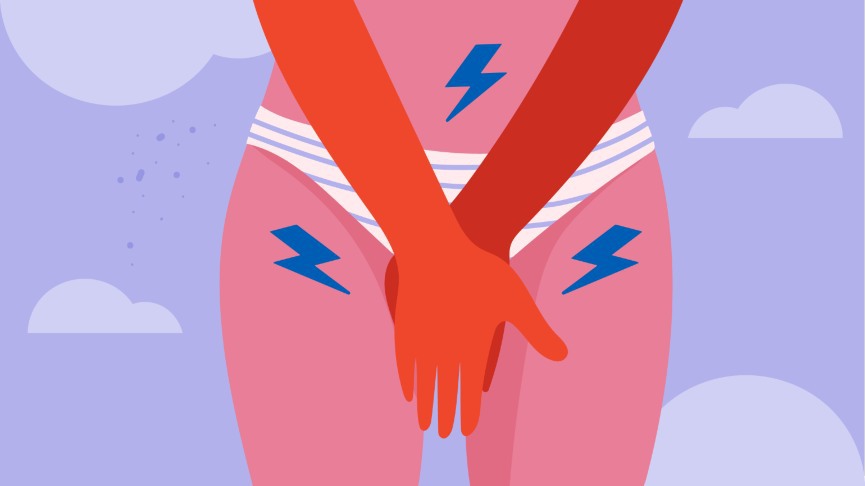Natural Yeast Infection Remedies: Do’s and Don’ts

That itch you can’t seem to scratch. Suspicious discharge. Irritation in the nether regions. Burn baby burn, you might just have a yeast infection.
Sound familiar? If so, we apologize.
Vaginal yeast infections are no fun. Quite the opposite of fun actually. They can ruin your mood, make it difficult to leave the house, and put a damper on your self-confidence. Considering that three out of four women will develop one at least once in their lifetime, it’s helpful to know what your treatment options are.
It’s important to know the signs of a yeast infection, Since many of these symptoms can be mistaken for an STI, you may want to see your doctor before treating it.
Just as a refresher (as if you needed a reminder), these are some common yeast infection symptoms to look out for:
- Vaginal rash
- Cottage cheese-like discharge
- Swelling, itching, and burning of the vulva and/or vagina
While there are plenty of helpful over the counter and prescription remedies available for yeast infections, for many people they would prefer to turn to natural remedies before turning to the pharmacy. This is especially true for people who have developed a resistance to the most common antifungal medications.
Don’t: Back Away from The Garlic
Researchers found that garlic may be effective in reversing fungus growth amongst eighteen strains of Candida, which can lead to yeast infections.
One old folk remedy is actually putting a clove of garlic into your vagina at the first sign of a yeast infection. The compounds in garlic that actually make it effective at treating fungal overgrowth are only released when it’s crushed or cut, so sticking a whole clove up there is not only probably ineffective, but possibly exposes your vagina to other pathogens.
Consuming garlic raw or cooked can help boost the immune system, which may in turn decrease your chances of getting a yeast infection.
Having said that, the use of a topical cream made from garlic and thyme may be helpful in treating yeast infections, especially for those who have a tolerance for or experienced side effects from standard topical creams.
Do: Say Yes to Yogurt
The lactobacillus bacteria in plain yogurt may be helpful in treating pesky yeast infections.
Eating plain yogurt may help suppress the growth of Candida, lowering your chance of developing a yeast infection. You can also take a probiotic supplement with lactobacillus.
Another common folk remedy is to actually put plain yogurt inside your vagina. A combination of plain yogurt and honey, which has natural antimicrobial properties, may reduce symptoms of a yeast infection.
How exactly do you go about putting yogurt into your vagina?
Of course, you can manually scoop a bit in and around the vulva, but one of the most common methods is by soaking a tampon in it, inserting the tampon, and then sitting on a towel while you cue up a show to binge watch.
While yogurt may not be as effective as traditional antifungal creams, it’s much more affordable, and comes with little to no risks, with the hopeful promise of immediate relief from itching and irritation, at least while inserted.
Many companies have developed probiotic suppositories that can be inserted into the vagina in lieu of yogurt.
Do: Use Herbal Medicine
Herbal medicine is one of the oldest tricks of the trade. Plants are powerful, and they work.
Tea tree essential oil used heavily diluted in a carrier like coconut oil, or a premade vaginal suppository may be helpful in treating yeast infections thanks to its antifungal properties.
Cream made with the flower calendula may be more helpful long term in treating vaginal yeast infections than other antifungal medications. Calendula is commonly used in baby products and postpartum, as well as to treat rashes and skin irritations. Meaning it’s extra gentle, but strong enough to help fight off infections.
Do: Think Ahead to help Prevent Yeast Infections
Of course one of the greatest cures nature has to offer is prevention. Knowing some of the hidden causes of yeast infections like excess alcohol and scented tampons, let’s you change your behavior and prevent them from happening in the first place – no pharmacy required.
- Go Commando: Tight fabrics, especially synthetic ones can irritate the sensitive tissue surrounding the vulva, and also make it easier for bacteria to creep from your rectum to your vagina, which can lead to a nasty infection. If you prefer to wear panties, try to opt for breathable cotton, and looser fitting clothes.
- Watch the Sugar: Candida feeds off of sugar, and a high amount of simple sugars in your diet may increase your risk of yeast infections while lowering your immune system.
- Avoid Antibiotics: While antibiotics can kill off harmful infection-causing bacteria, they also damage the good bacteria in your gut. Avoiding antibiotics when possible is essential in protecting the natural flora in your system.
Medical disclaimer – Although many of these remedies have been used for generations, not all of them have clinical research to back them up. It’s advised to check in with your provider before beginning any treatment protocol. Hormonal changes during pregnancy can make yeast infections more common. Again, be sure to check with your doctor or midwife if you have any symptoms of a yeast infection.
Just like yeast infections, UTIs may also be treatable or maintained through natural remedies.

Natasha (she/her) is a full-spectrum doula and health+wellness copywriter. Her work focuses on deconstructing the shame, stigma, and barriers people carry around birth, sex, health, and beyond, to help people navigate through their lives with more education and empowerment. You can connect with Natasha on IG @natasha.s.weiss.


